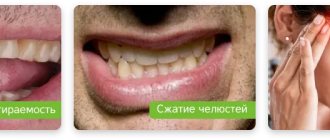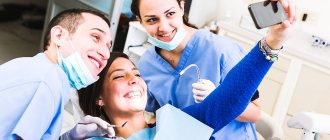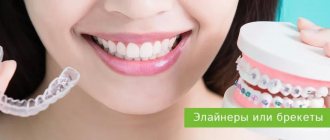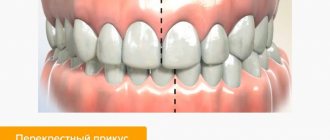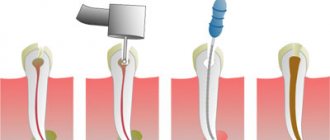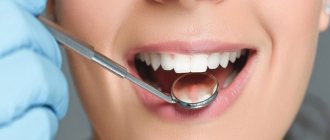Causes of Bruxism
There are several theories about the appearance of bruxism in adults. Psychological theory attaches great importance to the emotional state of a person in the development of the disease. Thus, factors favoring the development of bruxism may be the following:
- stress;
- high psycho-emotional stress;
- social and everyday disorder, troubles;
- frequent affective states.
The disease is called the disease of businessmen. People who undergo high psycho-emotional stress and take on great responsibility experience tension, which leads to involuntary muscle spasms during sleep. But it is important to understand that positive-minded patients can also suffer from this disease.
According to the neurogenic theory, the causes of bruxism in adults lie in disruption of the central and peripheral nervous system. This leads to neurological and movement disorders, muscle spasms. The validity of this theory is confirmed by the fact that, along with bruxism, sleep disorders (apnea, snoring, somnambulism) are often observed; tremor, epilepsy, enuresis - bedwetting. Tonic muscle tension can also be associated with damage to the trigeminal nerve.
Dental theory is based on the assumption that bruxism develops as a result of disturbances in the structure and function of the dental system. These include the following:
- bite defects;
- incorrect position of teeth;
- supernumerary teeth;
- crowded teeth;
- violation of the integrity of the dentition (partial adentia);
- incorrectly selected dentures and orthodontic structures;
- overestimation of fillings according to the bite;
- diseases of the temporomandibular joint.
Dental diseases lead to uneven distribution of the chewing load, and therefore the chewing muscles do not work properly. Her overexertion leads to nighttime cramps.
According to osteopathic theory, muscle contraction is an attempt by the neuromuscular system to eliminate blockage of the cranial sutures and restore craniosacral rhythm. This may be the result of birth trauma, malocclusion and posture, diseases of the cervical spine, etc.
Other theories about the origin of bruxism are not widely accepted, but some researchers link the problem to impaired nasal breathing, gastroesophageal reflux disease (GERD), parasitosis, frequent chewing of plates or pads, and other factors.
In any case, the causes of bruxism in an adult can be different, so it is difficult to do without a comprehensive diagnosis and the involvement of several specialized specialists.
Ask a Question
Psychological help
The psyche of children and teenagers is unstable. Therefore, psychological factors, including anxiety, often lead to the development of bruxism.
In an anxious state, other symptoms may be observed: the habit of pulling and twisting hair, biting nails, etc.
The trigger for bruxism can be changes in a child’s life: moving, changing schools, parents’ divorce, various conflicts, etc. In such cases, a psychologist will help.
Signs of Bruxism
An episode of nighttime teeth grinding lasts about 10 seconds. The number of episodes may vary and they may occur every night or occasionally. A characteristic symptom is grinding or clicking of teeth, but the patient himself rarely notices this feature, because sleep is not interrupted. Usually the patient learns about the problem from the lips of relatives and people living with him.
Associated symptoms of bruxism are the following:
- pain in the jaw, teeth;
- headache;
- pain in the facial muscles;
- dizziness;
- drowsiness.
Dangerous symptoms: when should you see a doctor?
The question of when to start treatment for bruxism in children worries many parents.
As a rule, the disease goes away on its own, without any consequences, by the age of 12–13 years. This is due to the fact that by this period the formation of molars is completed. No treatment is required for this form of bruxism. However, there are times when the picture is not so rosy. You should contact your doctor immediately if your child exhibits the following symptoms:
- headache and/or toothache in the morning;
- rapid wear of teeth;
- long and intense attacks at night (more than 10 seconds).
Complicated bruxism in children leads to quite unpleasant consequences, including gum disease and significant tooth wear.
Diagnostic methods
Diagnosis of bruxism involves studying the patient’s complaints, as well as assessing indirect signs based on the results of a routine visual examination. The leading method of objective diagnosis is the use of Brux Checkers - special mouthguards that are made on the basis of a plaster cast of the patient’s jaw. These aligners allow the detection of occlusal obstructions. The doctor issues brux checkers to wear overnight, after which the patient submits them to the clinic for analysis. Using diagnostic aligners, a specialist determines which teeth bear the greatest load.
Electromyography and polysomnography methods make it possible to register the pathological activity of the masticatory muscles and confirm the diagnosis of bruxism.
But, as a rule, it is possible to understand the reasons only with the help of comprehensive diagnostics. So, in the case of bruxism in adults, psychosomatics may occur, so consultation with a psychologist or psychotherapist will be required.
Complications of bruxism
If the disease is observed for a long time, pathological abrasion of the tooth enamel, increased sensitivity of the enamel, and the appearance of a wedge-shaped defect, cracks and chips may develop. Constant trauma to the periodontal tissues can lead to periodontitis, loosening and loss of teeth. The service life of fillings and orthopedic structures (prostheses) in patients with bruxism is shorter due to high mechanical load.
The consequence of the disease can be dysfunction of the temporomandibular joint, accompanied by pain in the jaw and neck, hypertrophy of the masticatory muscles.
Frequent injuries to the soft tissues of the oral cavity can lead to inflammatory diseases: gingivitis, periodontitis, stomatitis.
Pathological closing of the jaws during sleep complicates orthopedic and orthodontic treatment. Many dental restoration methods may not be available to patients, so it is important to pay attention to the disease in order to be able to receive comprehensive care in case of dental diseases or tooth loss.
There is a solution for each case!
1 procedure
1 Botulax procedure Gentle and safe effect For mild cases of hypertonicity of the masticatory muscles RUB 15,000. 15,000 rub.
3 procedures
A course of 3 Botulax procedures Gentle and safe effects For moderate and severe stages of hypertonicity RUB 35,000. 35,000 rub.
Botulinum therapy can help if you have a habit of clenching your jaw tightly and grinding your teeth, you suffer from increased abrasion of enamel and destruction of crowns.
Treatment methods for bruxism
Comprehensive treatment of bruxism may include medication, psychotherapy, physical therapy, and dental methods. This approach demonstrates the greatest efficiency.
The doctor will develop a treatment plan based on the severity of the disorder. It is very important to identify the causes in order to select adequate therapy.
In the case of exposure to psychogenic factors, the basis of treatment is cognitive behavioral therapy: the patient’s mastery of relaxation and self-control methods, psychotherapeutic trainings, art therapy, etc.
Drug therapy is aimed at reducing convulsive muscle activity. The main groups of funds include:
- magnesium, calcium preparations;
- B vitamins;
- mild sedatives;
- sleeping pills, etc.
Treatment of bruxism with botulinum toxin is also classified as a medicinal method. Botulinum toxin injections block nerve impulses entering the muscles, which relieves the muscles from involuntary spasms. The effect of botulinum toxin preparations is not permanent - after several months the injections are repeated. It is important to understand that this is rather a way to combat the symptom. Injections do not help eliminate the causes of the disease.
In some cases, osteopathic treatment may be recommended: manual therapy, massage, warming up the muscles with compresses.
The dental approach involves the participation of different specialists: periodontist, dental therapist, orthopedist, orthodontist. In the absence of pathologies in the dental system, protective rubber or plastic mouth guards are made, which helps prevent the consequences of bruxism in adults. According to indications, the following activities can be carried out:
- selective grinding of teeth;
- correction of bite by wearing mouthguards, braces;
- restoration of the integrity of the dentition: prosthetics and implantation.
Correction of bite defects is possible only after the patient’s condition improves. The installation of fillings and veneers, and splinting of teeth may be postponed due to the high risk of damage to structures.
Why is botulinum therapy not enough to eliminate hypertension?
You need to understand that Botox treatment in dentistry, like orthopedic treatment of bruxism (that is, the manufacture of special protective mouth guards for teeth during bruxism), is only an additional, and not an independent method. Botulinum therapy protects against the consequences of muscle strain - that is, visible relief will actually occur after administration of the drug. The spasm will go away, the muscles will relax, you will stop involuntarily clenching your jaw and thereby injuring your teeth. But as soon as the effect of botulinum toxin wears off, the problem may return, albeit to a lesser extent.
Of course, if it was just a formed habit based on nervousness, and the causes of bruxism are psychosomatic or neurological, then during treatment you have a good chance to completely get rid of it. But if the source lies in other pathologies and disorders, then you also need to address them: take care of your posture, solve bite problems, restore damaged teeth, replace low-quality dentures, etc. And botulinum therapy will become an effective comprehensive measure.
Prevention of bruxism
Bruxism can be prevented by paying attention to oral health: it is important to see a dentist in a timely manner, treat diseases of the teeth and gums, and restore the integrity of the dentition if teeth are lost. If you have bite defects or crowded teeth, you should consult an orthodontist.
Prevention involves normalizing the psycho-emotional state, giving up bad habits, coffee and energy drinks; maintaining a daily routine and proper nutrition.
Specialists from STOMA clinics will help adult patients get rid of bruxism: with us you can get help from all specialized doctors - from dental therapists to periodontists and orthodontists.
What should the mother do and how to help the child?
You can help your child cope with teeth grinding at home. The task of parents is to relax the child, especially in the evening. Suitable for relieving tension:
- massage;
- exercise therapy;
- correct daily routine;
- walks in the open air;
- drinking enough water;
- exclusion from the diet of foods that excite the nervous system: chocolate, coffee, tea, Coca-Cola, Pepsi, etc.;
- last meal – an hour before bedtime;
- hot bath before bed;
- refusal of active games, quiet activities in the evening: drawing, listening to lullabies, etc.
In addition, heart-to-heart conversations with your child can help. If the child does not speak out, he will go to bed with anxious thoughts. This will trigger an attack.
The following techniques will help reduce facial muscle tension:
- heat compresses (including for pain in the morning);
- chewing solid food;
- giving up chewing gum.
